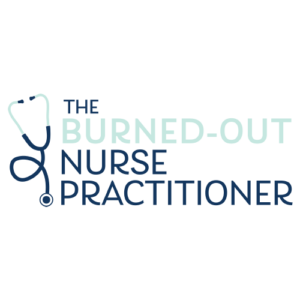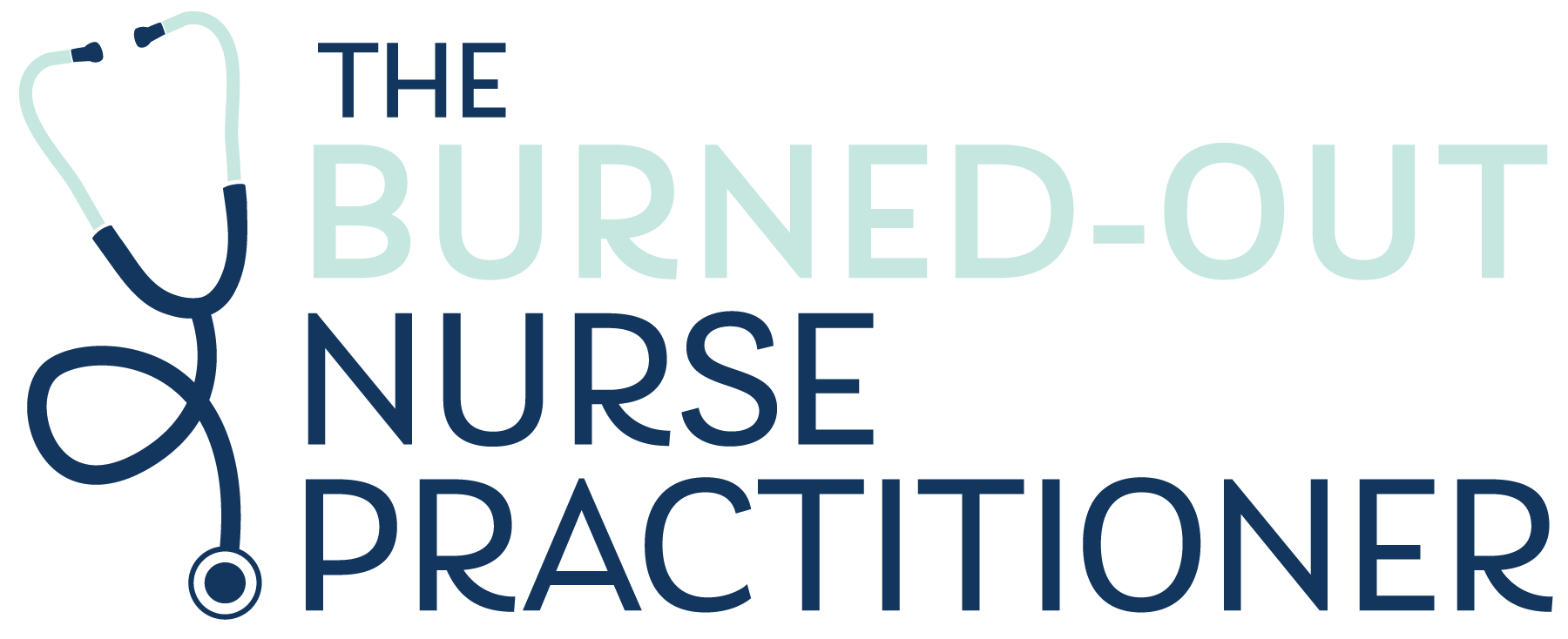As The Burned-out Nurse Practitioner, it is my mission to bring awareness of nurse practitioner burnout. Nurse practitioners play a vital (pun intended) role in caring for patients and making an impact in healthcare.
But with the demanding nature of work and challenges of the modern healthcare system nurse practitioner burnout is on a rise. We were burned-out before the COVID-19 pandemic, but the last three years in healthcare have been extremely difficult.
As The Burned-out Nurse Practitioner, it is my purpose to help overwhelmed nurse practitioners create a better work-life balance and overcome nurse practitioner burnout. Acknowledging risk factors for nurse practitioner burnout will help APRNs prevent the burnout and create a better work-life balance.
Risk factors of nurse practitioner burnout
High workload.
Excessive work demands, including long hours and a high patient load, is one of the risk factors of nurse practitioner burnout. With rising costs in healthcare and a push toward profitability, many employers are pushing nurse practitioners to see more patients in a shorter amount of time. Patients are scheduled at 10-15 minute increments (and often double booked)!
I realize these healthcare institutions need to make a profit in order to sustain, but the high workload takes a toll on nurse practitioners. Not to mention, seeing patients in a 10 minute time frame prevents us from having the time and energy to educate and truly care for the patient.
Lack of time.
Constantly feeling rushed and having limited time to complete tasks can increase stress levels and contribute to nurse practitioner burnout. As mentioned above, nurse practitioners face a high workload in many practice settings.
With patients double booked in 10-15 minute increments, it is hard to assess, diagnose, and treat the patient. Let alone document the findings. Then add on addressing the EHR inbox, full of diagnostic data to address, past medical records to review, completing medication refills, and the never-ending patient messages.
It’s no wonder nurse practitioners are having to stay late at the office or bring charts home! There is not enough time in the day to complete all these tasks. And the lack of time is one of the risk factors of nurse practitioner burnout.
Emotional and psychological challenges.
Nurse practitioners often face emotionally intense situations, such as witnessing patient suffering or dealing with life-threatening emergencies (also known as second victim syndrome). These situations are particularly prominent in settings such as acute care, emergency care, oncology, or mental health practices.
These traumatic experiences can lead to emotional exhaustion and burnout and create significant risk factors of nurse practitioner burnout. It is important to acknowledge the emotionally intense situations and address any personal feelings.
***Check out Burnout Resolution for Nurse Practitioners as there is a video lesson specific to nurse practitioners overcoming trauma.
Lack of control in practice.
Limited decision-making authority and a lack of control over work processes can contribute to feelings of frustration and disengagement, increasing the risk factors of nurse practitioner burnout.
I have definitely felt this with the tightening regulations from healthcare insurance companies. Nurse practitioners (or support staff) are required to complete an increasing number of prior authorizations. Whether it is for medications, diagnostic tests, or procedures, healthcare insurance companies are trying to avoid any excess healthcare costs that are not medically necessary.
Being required to complete these creates a lack of control in the patient’s care. I feel like I cannot even use my clinical judgment because I first have to abide by the health insurance regulations.
****Click here for 11 tips for improving your prior authorization process.
Lack of autonomy as nurse practitioners.
In several states, nurse practitioners need a supervising physician in order to practice in healthcare. This can be very frustrating and create a lack of autonomy for practicing nurse practitioners.
This requirement can create problems when nurse practitioners are starting their own practice. They have to pay a physician to supervise their practice even when that physician is not involved in the day to day work.
These regulations create added stress and lack of autonomy for nurse practitioners and is one of the risk factors for nurse practitioner burnout.
Inadequate staffing and resources.
Insufficient staffing levels and inadequate resources can place additional pressure on healthcare professionals, making it difficult to provide quality care and increasing risk factors of nurse practitioner burnout.
A lot of hospitals are seeing nursing staffing shortages. This makes it difficult for nurse practitioners to admit patients, transfer patients, or ensure they are receiving quality care. I have seen a lot of hospitals discharge patients 1-2 days too soon because there are not enough staff to care for them.
In clinic or urgent care settings there are staffing shortages including registered nurses (RNs), licensed practical nurses (LPNs), medical assistants (MAs), even front office or support staff. With the staffing shortages, nurse practitioners are having to take on more tasks that should be delegated.
Many NPs complete their own prior authorizations or set up referrals. Lots of nurse practitioners are having to respond to patient messages and calling patients back rather than delegating tasks to support staff. I have also seen nurse practitioners checking in their own patients: obtaining vital signs, reviewing past medical history, completing home medication reconciliation, administering medications, drawing labs, etc.
These are all tasks that are generally delegated to nurses or MAs, but with the staffing shortages nurse practitioners are having to complete. Adding additional tasks to a nurse practitioner’s already busy day creates risk factors of nurse practitioner burnout.
Organizational factors.
Poor leadership support, ineffective communication, lack of recognition, and a culture that prioritizes productivity over well-being can contribute to risk factors of nurse practitioner burnout.
A lot of nurse practitioners work in a toxic-work environment. They lack support from leadership. Nurse practitioners may lack job satisfaction and fulfillment in healthcare. They lack a say in how they care for patients. There is a push to see more patients, sicker patients in a shorter amount of time. They may work with coworkers or colleagues who belittle the knowledge and experience of nurse practitioners. They may have patients who demand care a certain way (many NPs have said this has worsened since the COVID-19 pandemic).
These organizational factors and toxic-work environments create risk factors of nurse practitioner burnout.
Work-life imbalance.
Difficulty in achieving a healthy balance between work and personal life can lead to chronic stress and create risk factors of nurse practitioner burnout. As previously mentioned in the lack of time section, many nurse practitioners have more work than they have time.
Nurse practitioners are staying late at the office or bringing charts home, disrupting their work-life balance. This lack of work-life balance puts strain on our personal relationships. NPs may experience mom guilt for not spending enough time with their children.
Nurse practitioners may lack the time to implement self-care. Or do those activities to bring them joy. This constant lack of work-life balance creates increased risk factors of nurse practitioner burnout.
Lack of social support.
Limited social support within the workplace and personal life can increase feelings of isolation and contribute to risk factors of nurse practitioner burnout. Nurse practitioner burnout is not a topic that is widely talked about. Many providers think the long work hours and organization factors are part of the job. This creates a feeling of isolation and lack of support when overcoming nurse practitioner burnout.
Some nurse practitioners do not have strong personal support. They may be taking on too many responsibilities at work and at home. These added stressors and lack of support create risk factors of nurse practitioner burnout.
*** Make sure to join The Burned-out Nurse Practitioner’s Facebook Group. The group is full of equally burned-out nurse practitioners ready to support one another.
Inadequate coping strategies.
Poor coping mechanisms or a lack of effective strategies to manage stress can leave nurse practitioners prone to burnout. Risk factors of nurse practitioner burnout is not something widely discussed. There are not enough training programs or support to help burned-out nurse practitioners.
That is why I created The Burned-out Nurse Practitioner, to help overwhelmed nurse practitioners create a better work-life balance and overcome burnout. I have talked with hundreds of nurse practitioners who are all struggling with the same kind of challenges.
Nurse practitioner is becoming a pandemic of its own and we have to do something about it! We have to take care of ourselves. We have to put our needs first. We have to create a better work-life balance! We have to do what is best for us!
***Check out The Burned-out NP’s blog page for more tips on overcoming nurse practitioner burnout. Also check out The Nurse Practitioner Charting School for time management and charting tips!
Personal characteristics.
Certain personal traits, such as perfectionism, self-criticism, and a tendency to prioritize others’ needs over their own, can increase the risk of burnout.
As nurse practitioners we are prone to burnout for several reasons. We are constantly putting others’ needs in front of our own. We take care of everyone BUT ourselves. Nurse practitioners may have signs and symptoms we need to set boundaries and may lack personal boundaries.
Whatever the case, we need to acknowledge how our personal traits play a role in our life and create risk factors of nurse practitioner burnout. Once we become aware of our inner strengths and weaknesses, we can better overcome nurse practitioner burnout.
Overcome nurse practitioner burnout
These are a few of the primary risk factors of nurse practitioner burnout. First nurse practitioners need to acknowledge which of these is affecting us the most. Then they need to create a plan to overcome nurse practitioner burnout. NPs need to seek support and guidance in their journey of creating a better work-life balance and overcoming burnout.
Here are a few resources offered by The Burned-out Nurse Practitioner.
- Burnout Resolution for Nurse Practitioners teaches NPs the framework and mindset shifts to empower you create a better work-life balance and resolve the burnout.
- The Burned-out Nurse Practitioner’s blog page offers tips and tricks for creating a better work-life balance and overcoming nurse practitioner burnout.
- The Nurse Practitioner Charting School is the one-stop for all documentation resources created specifically for nurse practitioners.
Make sure to join The Burned-out Nurse Practitioner’s Facebook Group. The group is full of equally burned-out nurse practitioners ready to support one another!

For time management and charting tips, check out The Nurse Practitioner Charting School– The one stop for all documentation resources created specifically for nurse practitioners. Learn more at www.npchartingschool.com

**Full disclosure, this blog post may include affiliate links. I do receive a commission if any of the affiliate programs/services/supplies are purchased. This is at no extra cost to you but does allow me to continue to provide content as The Burned-out Nurse Practitioner! Thank you!





2 Responses
ORGANIZATIONAL FACTORS! The elephant in the room is private equity. Couple private equity, who sees each of us and each patient we see, as a cash cow and a toxic group of co-workers and the result is a cesspool. We have multiple physicians who expect us to function exactly as they would and know exactly what they know but for a fraction of what they are paid. They do not respect us. They have commented on how we should not be allowed to wear white coats, because patients may get confused. The ads they run sound as if the surgeons are the only providers in the clinic. There is zero mention of our existence. Meanwhile, there are more NPs and PAs than surgeons in the clinic and most patients see the NPs and PAs. Our marketing department is just as clueless. On linkedIn they post the surgeons pictures and report on their birthdays. Meanwhile, you can have a mid-level report a close family member is in the ICU and the first question out of management is, “Did you secure coverage?” God forbid they lose a dime! When the relative dies while the employee is at work not one single person from management even has the decency to send a card or flowers. In case you are wondering, it was the mid-level’s parent!!
One minute we are expected to respond to any and all emergency calls in the clinic lobby and the next we are spoken to as if we don’t know our ass from our elbow. It is infuriating. We often get dumped on. We end up treating the most complex of patients while the physicians request they follow up with them as a “work-in.” Patients will call our clinic to schedule appointments and the scheduler will suggest urgent care as an option instead of making an appointment with a physician for services that range from discussing if a fracture will require surgery to second surgical opinions. Even though management knows it is not within our scope to provide these services, we are required to check the patients in, x-ray them and explain that they may or may not get the information they seek from a physician. We then make the patients a “work-in.” Often the physicians review the records and our notes only to decline the patient. THIS IS WRONG! We are also required to treat patients who have insurance our physicians do not accept thus leaving the patient nobody to follow up with after the initial work-up. This is particularly dicey when we encounter surgical fractures our physicians are more than capable of treating, but due to low reimbursement refuse to accept their insurance leaving us left holding the bag and having to explain that they cannot be treated at our facility. When we tell patients on the front end that they are better off starting initial care elsewhere for continuity of care management gets upset. We also have a self pay policy. We charge $350 per visit. We often get patients who have been seen in an ER and stabilized. There is nothing we as an urgent care can offer the patient. They need a surgical consult at this time. When we tell patients we will be more than happy to see you today, offer you nothing over and beyond what has already been done and charge $350 simply to make you an appointment with a surgeon who will also charge you $350, we get reprimanded. Medicine is beyond broken. It has become an unethical money grab and it is so disheartening. Burnout is for a very sinister reason.
Sounds like you have experienced multiple frustrations in healthcare! Unfortunately this is the case for many nurse practitioners, hence the increase in burnout rates!